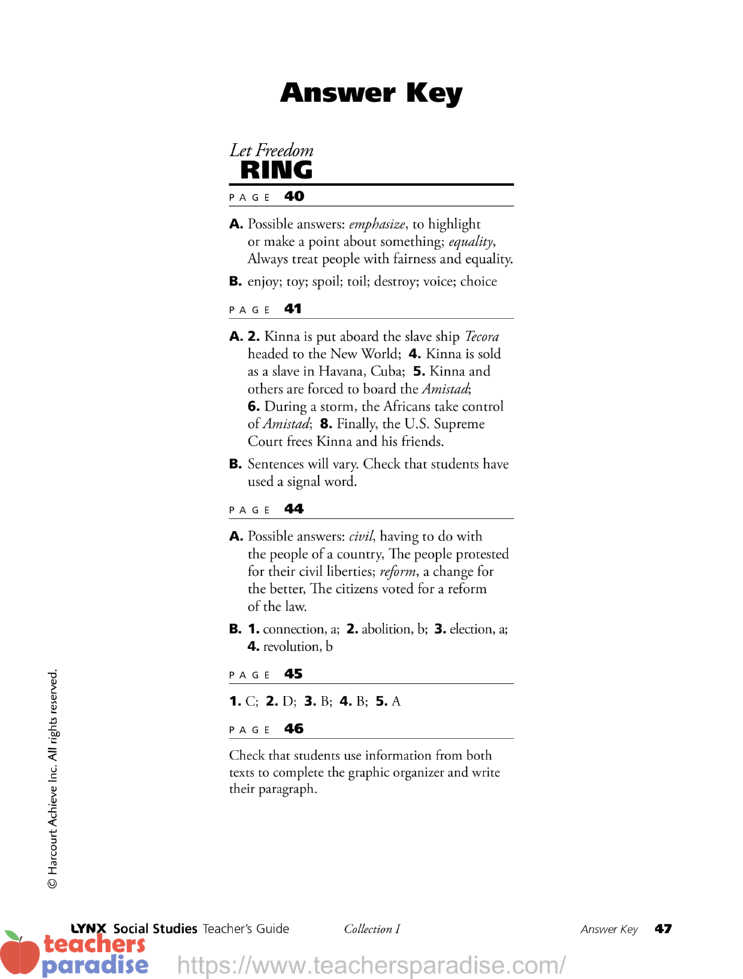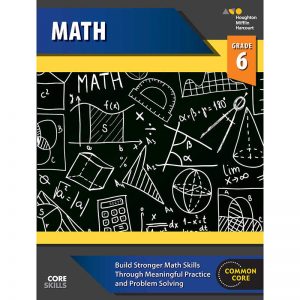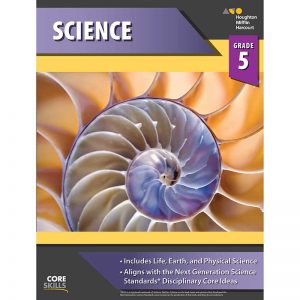Let Freedom Ring Teacher’s Guide
GRAPHIC NOVEL
Summary
A group of Africans is captured and sold into slavery. In Cuba, they are loaded onto the Amistad. Fighting for freedom, they take the ship and try to return home. They ultimately stand trial in the United States, where a former president pleads their case.
NONFICTION BOOK
Summary
Examine the role of music in the U.S. Civil Rights movement, as well as the contributions of Rosa Parks and Dr. Martin Luther King Jr. Compare this to music’s place in the struggle for equal rights in South Africa and Nelson Mandela’s inspiring story.
Links to Social Studies
Why History Matters
There are similarities and differences within cultures in different societies.
WORKSHEET & Sample PDF Activity
[adinserter block=”2″]
Sample PDF Activity
[adinserter block=”3″]
World History
- Economic, political, and cultural links occurred among Africa, Europe, and the Americas between 1500 and the present. 2. Europeans colonized the African continent and brought enslaved Africans to their colonies in the New World.
American History
The values of European economics took root in the colonies, and slavery reshaped European and African life in the Americas.
Geography
Culture and experience influence people’s perceptions of places and regions.
Links to Reading/Language Arts
Comprehension Sequence of Events
Vocabulary Four-Square Charts
Phonics/Word Study Diphthong/Suffixes
Text Feature Timelines
Literary Analysis Character Traits
Nonfiction Genre Interview
Vocabulary Links
describe (verb) to tell or write about something
discrimination (noun) prejudiced treatment or action against someone or something by others
emphasize (verb) to highlight or make a point about something
equality (noun) fair or equal treatment for everyone
justice (noun) the upholding of equal rights for all persons under the law
civil (adjective) having to do with the people of a country, not its military or religion
reform (noun) a change for the better; an improvement
Links to Textbooks
World History Units
• Early modern world
• Industry and nationalism
• Contemporary issues
American History Units
• North/South Division
• America today
Geography Units
• United States
• Southern Africa
Let Freedom Ring GRAPHIC NOVEL
STEP 1 Introduce Theme
Make a Personal Connection
Ask students to discuss where their ancestors lived before coming to America. Explain that many African Americans were forced to come to America to work as slaves.
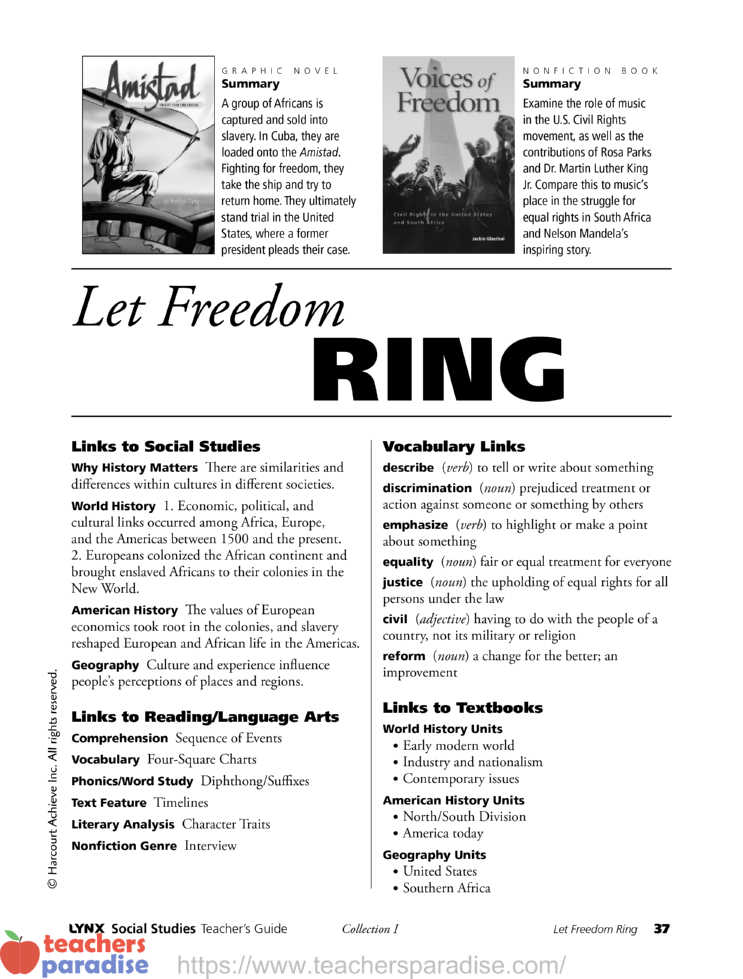
Build Theme Background
Ask students to share what they know about slavery. Discuss how Africans were captured and brought to America as enslaved people. Review the Big Ideas on page 2 of Amistad and discuss them with students.
Preview Text
Distribute copies of Amistad, and discuss the cover illustration. Ask What do you think is happening on the cover? Who do you think the man might be?
• Preview what Kinna says on pages 2 and 3. Ask students What do you think will happen to Kinna?
• Have students preview pages 4–11 and make predictions about the story and the characters.
STEP 2 Build Word Power
Teach Vocabulary Strategy: Four-Square Charts
Introduce the vocabulary words on page 3. Then, create a four-square chart on the board, like the one on page 40.
• Write justice in the word box. Invite students to supply the word’s meaning and use the word in a sentence as you write. Select a volunteer to draw a picture about the word.
• Have students complete a four-square chart with equality.
Review Phonics: Diphthong /oi/ oi, oy
Explain to students that they can sound out more words if they learn the sound/spellings of vowel pairs.
• Print join on the board. Model how to blend the sounds in the word by running your finger under each sound. Let one sound merge into the next without a pause: jjjoooiiinnn. Repeat the blending a second time, but compress each sound: jooiin. Then, say the word normally: join.
• Repeat with the following words: noise, enjoy, soil, choice, voyage.
• Ask students to generate more words with the vowel pairs oi or oy that makes the diphthong /oi/. (boil, joy, cowboy)
Support English Language Learners: Homographs
Explain that some words are spelled the same but have different meanings.
• Turn to page 6 and point out beat in panel 4. Ask students what this word means. (to hit) Ask students what the word beat means in the following sentences: Our team beat the visiting team (defeated); I like the beat of this song (rhythm). Invite students to use each word with its distinct meaning in their own sentences.
• Other homographs in this book that you can use as examples are felt, close, treat, stick, wound, might, board, deck, and court.
STEP 3 Build Reading Power
Teach Comprehension Skill: Sequence of Events
Explain to students that the sequence of events in a story is the order in which events happen. Explain that understanding what happens first, second, third, and so on, will help them understand what they read. Discuss these signal words for sequence: first, second, before, after, then, later, while, afterwards, finally.
Model Comprehension Strategy: Sequence of Events
Say First, Kinna walked toward the market. Next, he was captured. Then, he was placed on a slave ship. Explain that this sequence of events occurs early in the story. The signal words first, next, and then help you understand the order in which things happened to Kinna.
Begin Reading Amistad
Have students read pages 1–13. Remind them to think about the sequence of events described in the story as they read.
Apply Comprehension Strategy
Have students find the word that signals sequence in this sentence on page 7 Then a strange ship arrived.
• Have students look at the surrounding panels and tell what happened before, how much time passed, and what happened later to Kinna and the other Africans.
STEP 4 Support Understanding
Show Literacy in Action: Timelines
Point out the timeline on page 20, and explain how the dates and events are organized. Timelines make it easier to understand a sequence of events. Ask Which years does this timeline cover? Ask students how many years they would include in a timeline of their lives to this point.
Focus on Literary Analysis: Character Traits
Thinking about how characters act helps you understand a story better. Ask How would you describe Kinna at the beginning of the story? How has he changed by the middle of the story? Invite students to share how they might behave in Kinna’s circumstances.
Accommodate for Learning Differences: Character Sketches
Have students draw or trace one character from the story. Ask them to label their drawings with adjectives that describe the character. Encourage them to use words that describe the character’s personality. (friendly, afraid, cruel, greedy)
Finish Reading Amistad
Remind students to confirm or revise their earlier predictions about the story and the characters.
STEP 5 Wrap Up Graphic Novel
Discuss Amistad
Lead a discussion using the following prompts:
• What happened to Kinna and the others soon after they completed the middle passage?
• How do you think Kinna felt when he learned he was free?
Practice Master 1
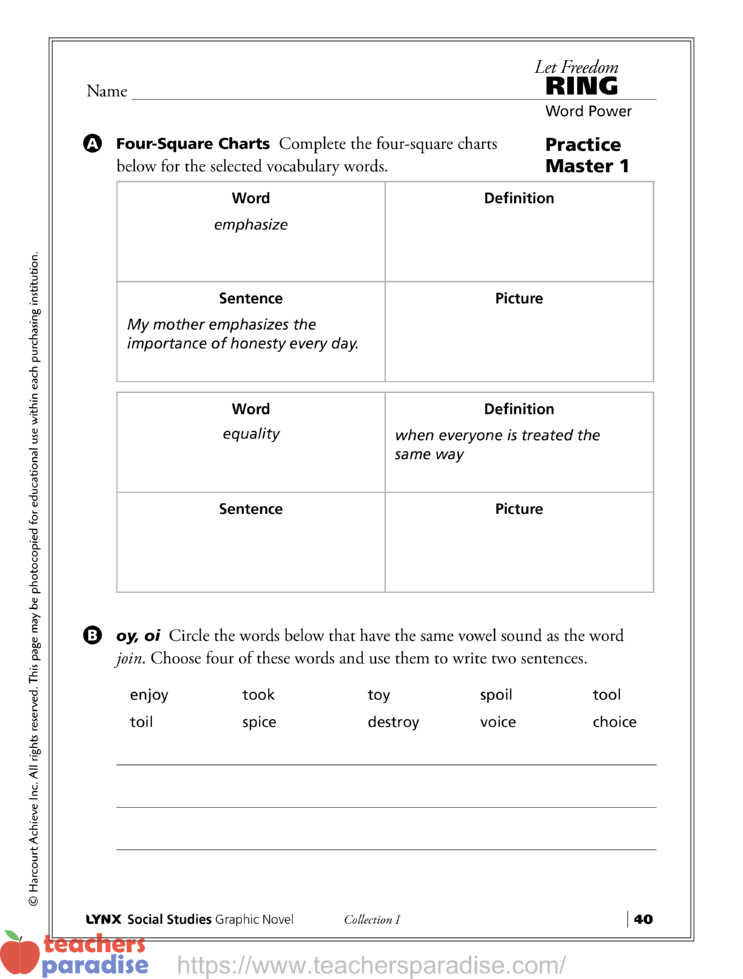
A. Four-Square Charts
Complete the four-square charts below for the selected vocabulary words.
B. oy, oi
Circle the words below that have the same vowel sound as the word join. Choose four of these words and use them to write two sentences.
enjoy took toy spoil tool
toil spice destroy voice choice
Practice Master 2
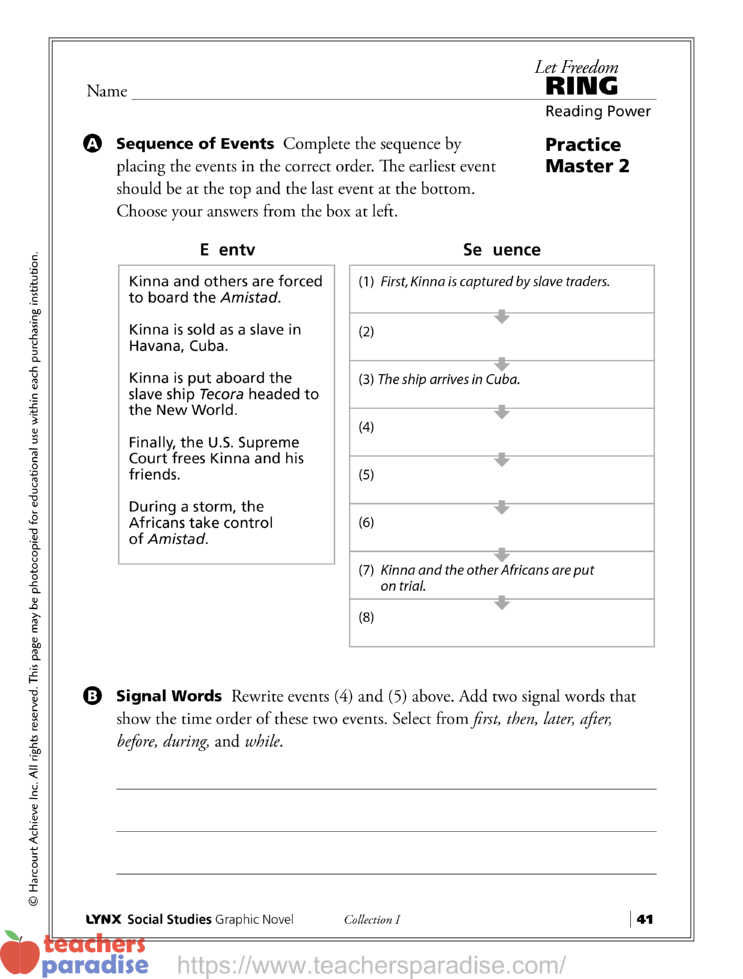
A. Sequence of Events
Complete the sequence by placing the events in the correct order. The earliest event should be at the top and the last event at the bottom. Choose your answers from the box at left.
B. Signal Words
Rewrite events (4) and (5) above. Add two signal words that show the time order of these two events. Select from first, then, later, after, before, during, and while.
Let Freedom Ring NONFICTION BOOK
STEP 1 Connect Theme Across Texts
Build Prior Knowledge from Reading
Review pages 16–20 of Amistad.
Ask Do you remember how the Africans won their freedom on the Amistad? Why was it important for them to fight for their rights? How can people fight for their rights without violence today? Review pages 12–14 and discuss students’ ideas about the actions the slaves took to free themselves. Ask What other countries have had conflicts over equal rights?
STEP 2 Build Word Power
Review Vocabulary Strategy: Four-Square Charts
Introduce the new vocabulary words civil and reform and create four-square charts for them. Invite volunteers to define the words and use each word in a sentence. Have students illustrate the words, writing a caption for their drawings.
Teach Word Study Strategy: Suffix -tion
Some verbs can be changed into nouns by adding the suffix -tion. Recognizing the -tion suffix can help you figure out unfamiliar words when reading. Sometimes a letter or letters must be changed or added.
• Write information on the board. Explain that the letter a plus the suffix -tion is added to the verb inform to make the noun information, which means the facts or knowledge one person tells another. Repeat with the words fascination (fascinate), discrimination (discriminate), action (act), and animation (animate).
Support English Language Learners: Time Words
English language learners often need help with words about time. Review with students time-related words in Voices of Freedom and apply to real-world events. For example, What do you like to spend time doing? What do you do in the evening between 7 and 8? Do you listen to the radio while you are in a car?
STEP 3 Build Reading Power
Review Comprehension Strategy: Sequence of Events
Remind students that a sequence of events is the order in which things happen. Read the Introduction of Voices of Freedom together. Ask students questions using order words, for example What happened first? Then what happened?
Begin Reading Voices of Freedom
Have students read chapters 1 and 2 on their own. Remind them to use what they have learned so far as they read the selection.
Link to Student Research Topics
To learn more, students can investigate:
• the continued controversy over affirmative action in the United States
• the illicit but continuing use of slave labor in the world today
• the roles of music and celebrities in election campaigns
STEP 4 Support Understanding
Focus on Nonfiction Genre: Interview
Explain to students that recognizing an interview will help them understand what they read. An interview is a type of conversation between two people. The interviewer asks questions. The interviewee answers the questions. An interviewer wants to get information. Ask students to write three questions they would like to ask one of the people described in Voices of Freedom.
Focus on Text Feature: Timelines
Timelines show the order in which important events happened. Read the title of the timeline on page 19. Invite volunteers to each read a date and important event. Ask students to describe how this timeline helps explain events from the Civil Rights movement.
Accommodate Learning Differences: Timelines
Copy and enlarge the timeline on page 19 and cut it into segments, one for each event. Give students the pieces, and instruct them to read the date and event. Then, help them reassemble the timeline in correct order. Have them tell how they knew the order of the pieces.
Finish Reading Voices of Freedom
Remind students to use what they have learned as they read.
STEP 5 Wrap Up Theme
Discuss Voices of Freedom
Discuss the following with students:
• Who in this book would you like to interview? What is the most important question you would ask this person? Why?
• What important events in the Civil Rights movement happened just before Rosa Parks refused to give up her seat? Just after?
• If you created a timeline of your life, what are some important dates and events that you would include?
Link to Why History Matters
Explain to students that racism made
slavery and racial discrimination possible in the United States and that it still has not been eliminated. Similar racist attitudes created the apartheid system in South Africa. Understanding history will help defeat racism. Slavery also has economic causes. Poor people are still being enslaved in some parts of the world. Understanding how terrible slavery is will encourage people to take action to stop modern-day slavery.
Analyze and Write Across Texts
Ask students to use both books to describe how slavery and apartheid denied people their basic rights.
• Assign students a short essay explaining how laws and attitudes about basic rights have changed since the time of slavery and apartheid. They should also include some of the reasons for the changes.
Link Theme to Textbook
Preview headings, images, captions, and text features in: World History Units on the early modern world, industrialization, nationalism, and contemporary issues; American History Units on North/South division and America today; or Geography Units on the United States and Southern Africa. Have students make predictions based on what they’ve learned.
Practice Master 3
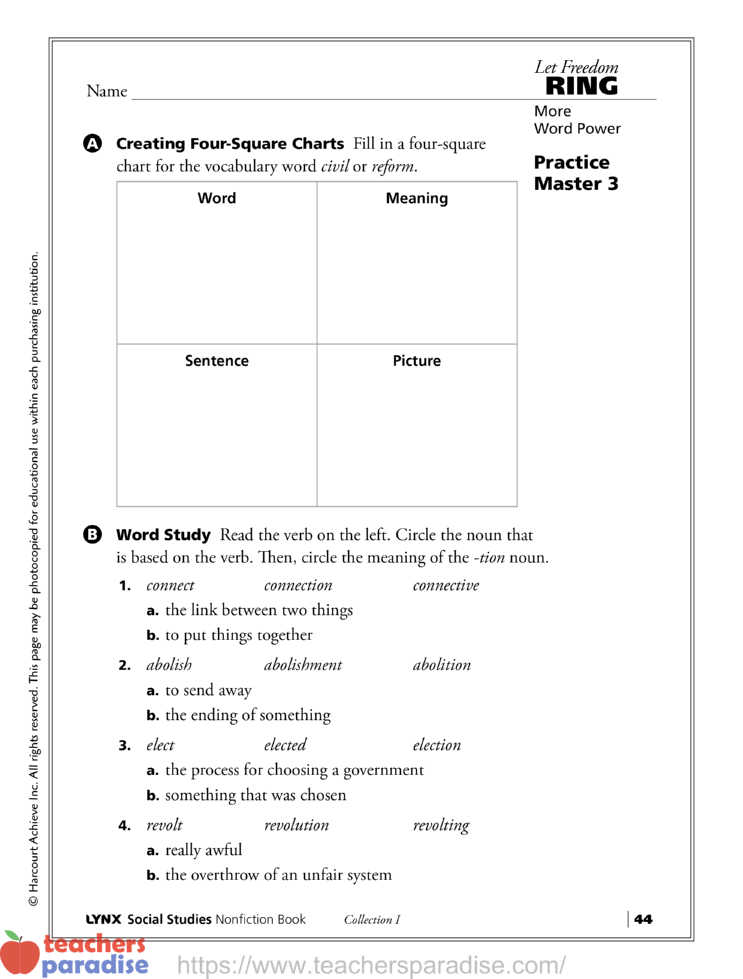
A. Creating Four-Square Charts
Fill in a four-square chart for the vocabulary word civil or reform.
B. Word Study
Read the verb on the left. Circle the noun that is based on the verb. Then, circle the meaning of the -tion noun.
- connect connection connective
a. the link between two things
b. to put things together - abolish abolishment abolition
a. to send away
b. the ending of something - elect elected election
a. the process for choosing a government
b. something that was chosen - revolt revolution revolting
a. really awful
b. the overthrow of an unfair system
Practice Master 4
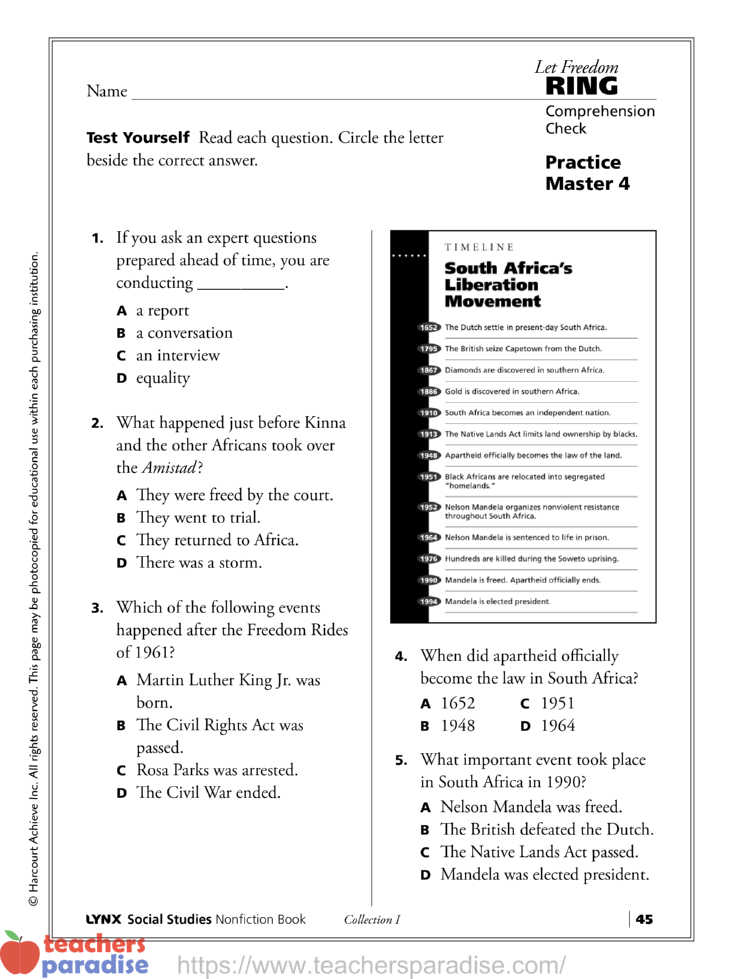
Test Yourself
Read each question. Circle the letter beside the correct answer.
- If you ask an expert questions prepared ahead of time, you are conducting __.
A. a report
B. a conversation
C. an interview
D. equality - What happened just before Kinna and the other Africans took over the Amistad ?
A. They were freed by the court.
B. They went to trial.
C. They returned to Africa.
D. There was a storm. - Which of the following events happened after the Freedom Rides of 1961?
A. Martin Luther King Jr. was born.
B. The Civil Rights Act was passed.
C. Rosa Parks was arrested.
D. The Civil War ended. - When did apartheid officially become the law in South Africa?
A. 1652
B. 1948
C. 1951
D. 1964 - What important event took place in South Africa in 1990?
A. Nelson Mandela was freed.
B. The British defeated the Dutch.
C. The Native Lands Act passed.
D. Mandela was elected president.
Practice Master 5
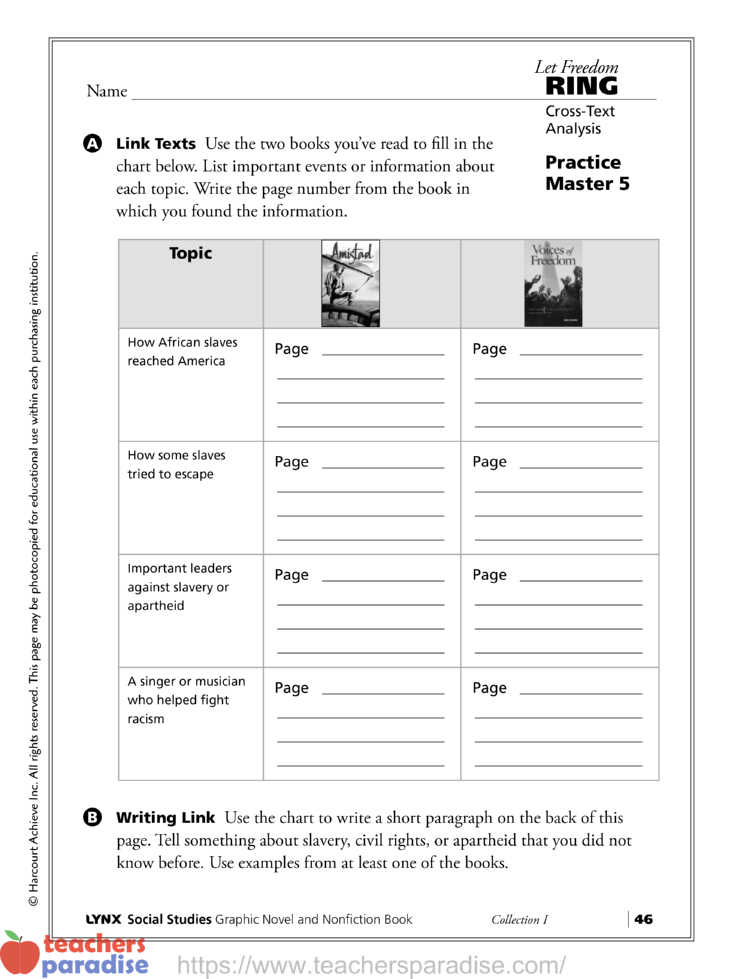
A. Link Texts
Use the two books you’ve read to fill in the chart below. List important events or information about each topic. Write the page number from the book in which you found the information.
B. Writing Link
Use the chart to write a short paragraph on the back of this page. Tell something about slavery, civil rights, or apartheid that you did not know before. Use examples from at least one of the books.
LYNX Let Freedom Ring – Answer Key
